Assessment of Australia's Cultural Tourism Sector: PEST & Scenarios
VerifiedAdded on 2023/06/04
|7
|1621
|341
Essay
AI Summary
This essay provides an assessment of the cultural tourism sector, focusing on Australia. It employs a PEST analysis to examine the political, economic, social, and technological factors influencing the industry. The essay further explores potential future scenarios for cultural tourism, including the 'Southern Experience,' 'Global Emotions,' and 'Sin Surprise' scenarios, highlighting the impact of economic growth, global accessibility, and changing tourist preferences. The conclusion emphasizes the importance of preserving heritage and sustainably developing the cultural tourism industry, noting its role in knowledge dissemination and heritage conservation. Desklib offers students access to this and other solved assignments for academic support.
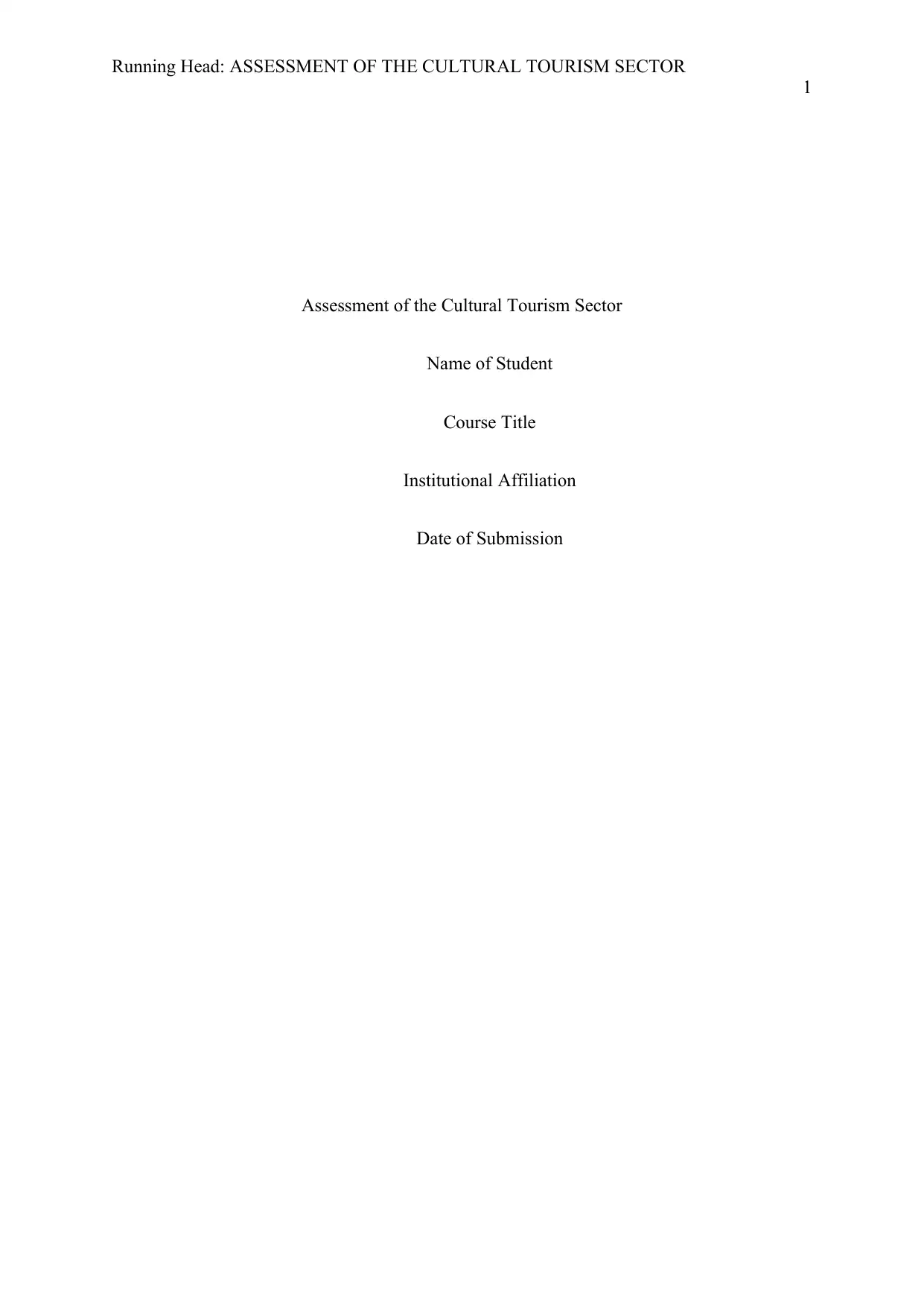
Running Head: ASSESSMENT OF THE CULTURAL TOURISM SECTOR
1
Assessment of the Cultural Tourism Sector
Name of Student
Course Title
Institutional Affiliation
Date of Submission
1
Assessment of the Cultural Tourism Sector
Name of Student
Course Title
Institutional Affiliation
Date of Submission
Paraphrase This Document
Need a fresh take? Get an instant paraphrase of this document with our AI Paraphraser
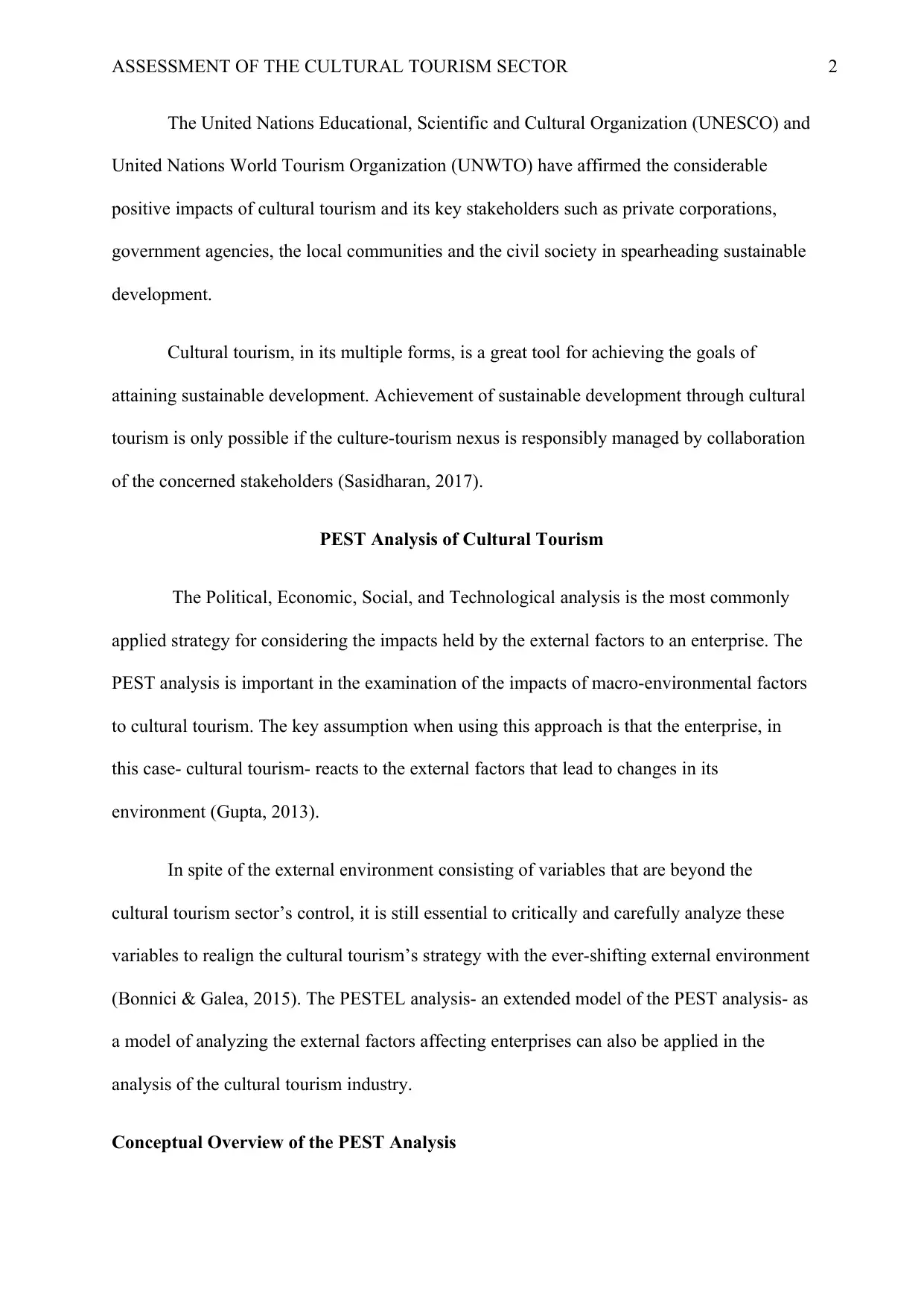
ASSESSMENT OF THE CULTURAL TOURISM SECTOR 2
The United Nations Educational, Scientific and Cultural Organization (UNESCO) and
United Nations World Tourism Organization (UNWTO) have affirmed the considerable
positive impacts of cultural tourism and its key stakeholders such as private corporations,
government agencies, the local communities and the civil society in spearheading sustainable
development.
Cultural tourism, in its multiple forms, is a great tool for achieving the goals of
attaining sustainable development. Achievement of sustainable development through cultural
tourism is only possible if the culture-tourism nexus is responsibly managed by collaboration
of the concerned stakeholders (Sasidharan, 2017).
PEST Analysis of Cultural Tourism
The Political, Economic, Social, and Technological analysis is the most commonly
applied strategy for considering the impacts held by the external factors to an enterprise. The
PEST analysis is important in the examination of the impacts of macro-environmental factors
to cultural tourism. The key assumption when using this approach is that the enterprise, in
this case- cultural tourism- reacts to the external factors that lead to changes in its
environment (Gupta, 2013).
In spite of the external environment consisting of variables that are beyond the
cultural tourism sector’s control, it is still essential to critically and carefully analyze these
variables to realign the cultural tourism’s strategy with the ever-shifting external environment
(Bonnici & Galea, 2015). The PESTEL analysis- an extended model of the PEST analysis- as
a model of analyzing the external factors affecting enterprises can also be applied in the
analysis of the cultural tourism industry.
Conceptual Overview of the PEST Analysis
The United Nations Educational, Scientific and Cultural Organization (UNESCO) and
United Nations World Tourism Organization (UNWTO) have affirmed the considerable
positive impacts of cultural tourism and its key stakeholders such as private corporations,
government agencies, the local communities and the civil society in spearheading sustainable
development.
Cultural tourism, in its multiple forms, is a great tool for achieving the goals of
attaining sustainable development. Achievement of sustainable development through cultural
tourism is only possible if the culture-tourism nexus is responsibly managed by collaboration
of the concerned stakeholders (Sasidharan, 2017).
PEST Analysis of Cultural Tourism
The Political, Economic, Social, and Technological analysis is the most commonly
applied strategy for considering the impacts held by the external factors to an enterprise. The
PEST analysis is important in the examination of the impacts of macro-environmental factors
to cultural tourism. The key assumption when using this approach is that the enterprise, in
this case- cultural tourism- reacts to the external factors that lead to changes in its
environment (Gupta, 2013).
In spite of the external environment consisting of variables that are beyond the
cultural tourism sector’s control, it is still essential to critically and carefully analyze these
variables to realign the cultural tourism’s strategy with the ever-shifting external environment
(Bonnici & Galea, 2015). The PESTEL analysis- an extended model of the PEST analysis- as
a model of analyzing the external factors affecting enterprises can also be applied in the
analysis of the cultural tourism industry.
Conceptual Overview of the PEST Analysis
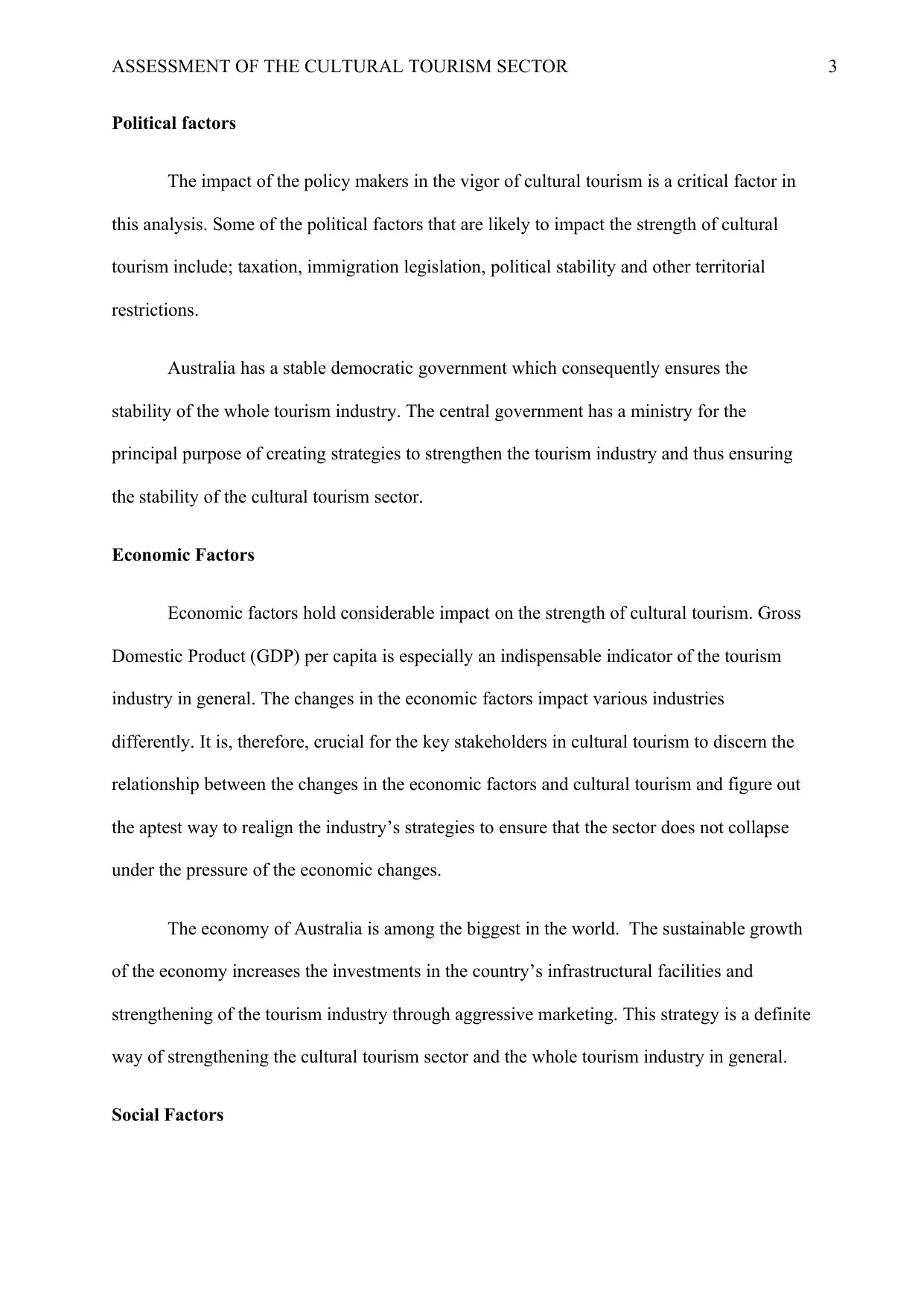
ASSESSMENT OF THE CULTURAL TOURISM SECTOR 3
Political factors
The impact of the policy makers in the vigor of cultural tourism is a critical factor in
this analysis. Some of the political factors that are likely to impact the strength of cultural
tourism include; taxation, immigration legislation, political stability and other territorial
restrictions.
Australia has a stable democratic government which consequently ensures the
stability of the whole tourism industry. The central government has a ministry for the
principal purpose of creating strategies to strengthen the tourism industry and thus ensuring
the stability of the cultural tourism sector.
Economic Factors
Economic factors hold considerable impact on the strength of cultural tourism. Gross
Domestic Product (GDP) per capita is especially an indispensable indicator of the tourism
industry in general. The changes in the economic factors impact various industries
differently. It is, therefore, crucial for the key stakeholders in cultural tourism to discern the
relationship between the changes in the economic factors and cultural tourism and figure out
the aptest way to realign the industry’s strategies to ensure that the sector does not collapse
under the pressure of the economic changes.
The economy of Australia is among the biggest in the world. The sustainable growth
of the economy increases the investments in the country’s infrastructural facilities and
strengthening of the tourism industry through aggressive marketing. This strategy is a definite
way of strengthening the cultural tourism sector and the whole tourism industry in general.
Social Factors
Political factors
The impact of the policy makers in the vigor of cultural tourism is a critical factor in
this analysis. Some of the political factors that are likely to impact the strength of cultural
tourism include; taxation, immigration legislation, political stability and other territorial
restrictions.
Australia has a stable democratic government which consequently ensures the
stability of the whole tourism industry. The central government has a ministry for the
principal purpose of creating strategies to strengthen the tourism industry and thus ensuring
the stability of the cultural tourism sector.
Economic Factors
Economic factors hold considerable impact on the strength of cultural tourism. Gross
Domestic Product (GDP) per capita is especially an indispensable indicator of the tourism
industry in general. The changes in the economic factors impact various industries
differently. It is, therefore, crucial for the key stakeholders in cultural tourism to discern the
relationship between the changes in the economic factors and cultural tourism and figure out
the aptest way to realign the industry’s strategies to ensure that the sector does not collapse
under the pressure of the economic changes.
The economy of Australia is among the biggest in the world. The sustainable growth
of the economy increases the investments in the country’s infrastructural facilities and
strengthening of the tourism industry through aggressive marketing. This strategy is a definite
way of strengthening the cultural tourism sector and the whole tourism industry in general.
Social Factors
⊘ This is a preview!⊘
Do you want full access?
Subscribe today to unlock all pages.

Trusted by 1+ million students worldwide
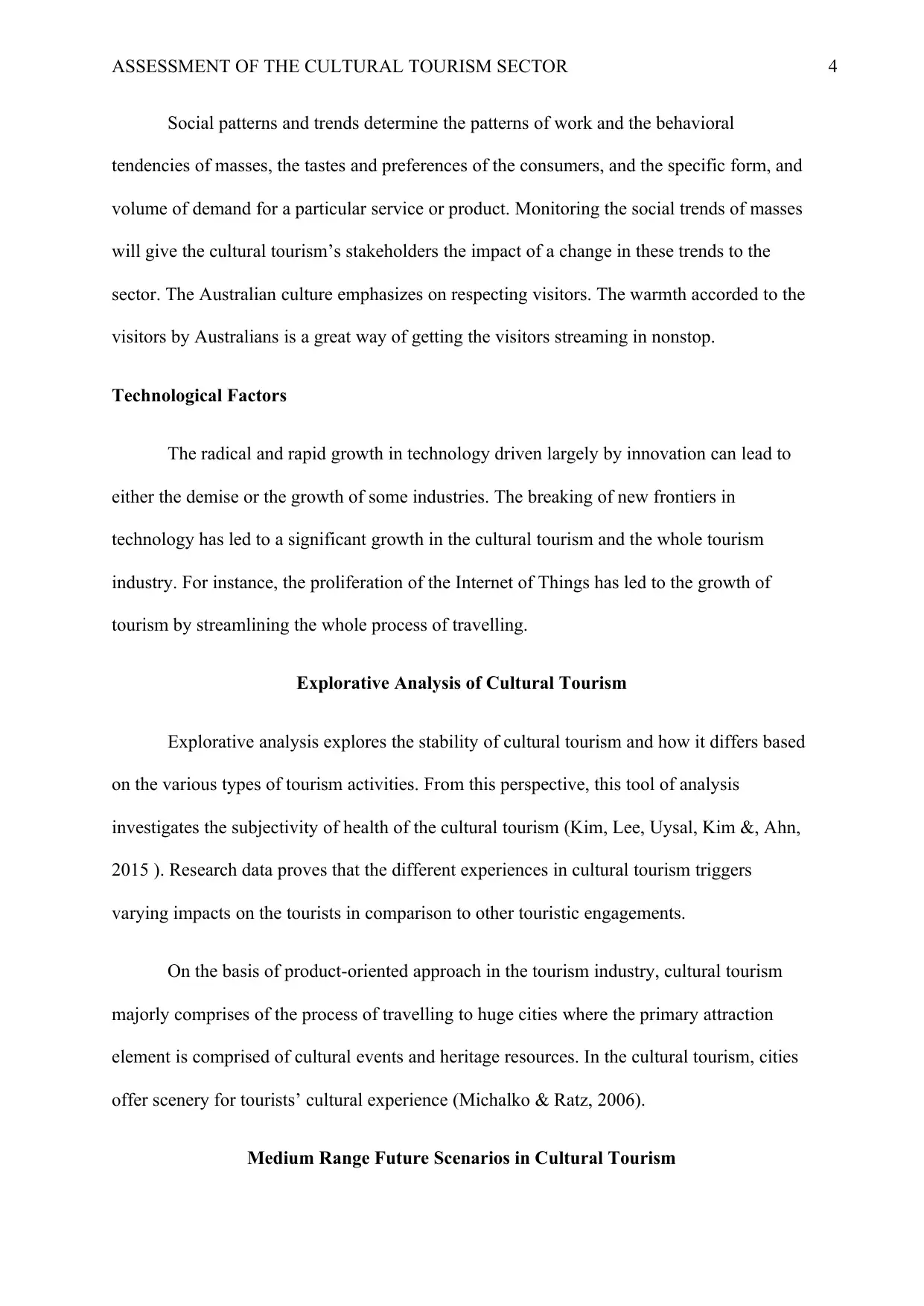
ASSESSMENT OF THE CULTURAL TOURISM SECTOR 4
Social patterns and trends determine the patterns of work and the behavioral
tendencies of masses, the tastes and preferences of the consumers, and the specific form, and
volume of demand for a particular service or product. Monitoring the social trends of masses
will give the cultural tourism’s stakeholders the impact of a change in these trends to the
sector. The Australian culture emphasizes on respecting visitors. The warmth accorded to the
visitors by Australians is a great way of getting the visitors streaming in nonstop.
Technological Factors
The radical and rapid growth in technology driven largely by innovation can lead to
either the demise or the growth of some industries. The breaking of new frontiers in
technology has led to a significant growth in the cultural tourism and the whole tourism
industry. For instance, the proliferation of the Internet of Things has led to the growth of
tourism by streamlining the whole process of travelling.
Explorative Analysis of Cultural Tourism
Explorative analysis explores the stability of cultural tourism and how it differs based
on the various types of tourism activities. From this perspective, this tool of analysis
investigates the subjectivity of health of the cultural tourism (Kim, Lee, Uysal, Kim &, Ahn,
2015 ). Research data proves that the different experiences in cultural tourism triggers
varying impacts on the tourists in comparison to other touristic engagements.
On the basis of product-oriented approach in the tourism industry, cultural tourism
majorly comprises of the process of travelling to huge cities where the primary attraction
element is comprised of cultural events and heritage resources. In the cultural tourism, cities
offer scenery for tourists’ cultural experience (Michalko & Ratz, 2006).
Medium Range Future Scenarios in Cultural Tourism
Social patterns and trends determine the patterns of work and the behavioral
tendencies of masses, the tastes and preferences of the consumers, and the specific form, and
volume of demand for a particular service or product. Monitoring the social trends of masses
will give the cultural tourism’s stakeholders the impact of a change in these trends to the
sector. The Australian culture emphasizes on respecting visitors. The warmth accorded to the
visitors by Australians is a great way of getting the visitors streaming in nonstop.
Technological Factors
The radical and rapid growth in technology driven largely by innovation can lead to
either the demise or the growth of some industries. The breaking of new frontiers in
technology has led to a significant growth in the cultural tourism and the whole tourism
industry. For instance, the proliferation of the Internet of Things has led to the growth of
tourism by streamlining the whole process of travelling.
Explorative Analysis of Cultural Tourism
Explorative analysis explores the stability of cultural tourism and how it differs based
on the various types of tourism activities. From this perspective, this tool of analysis
investigates the subjectivity of health of the cultural tourism (Kim, Lee, Uysal, Kim &, Ahn,
2015 ). Research data proves that the different experiences in cultural tourism triggers
varying impacts on the tourists in comparison to other touristic engagements.
On the basis of product-oriented approach in the tourism industry, cultural tourism
majorly comprises of the process of travelling to huge cities where the primary attraction
element is comprised of cultural events and heritage resources. In the cultural tourism, cities
offer scenery for tourists’ cultural experience (Michalko & Ratz, 2006).
Medium Range Future Scenarios in Cultural Tourism
Paraphrase This Document
Need a fresh take? Get an instant paraphrase of this document with our AI Paraphraser
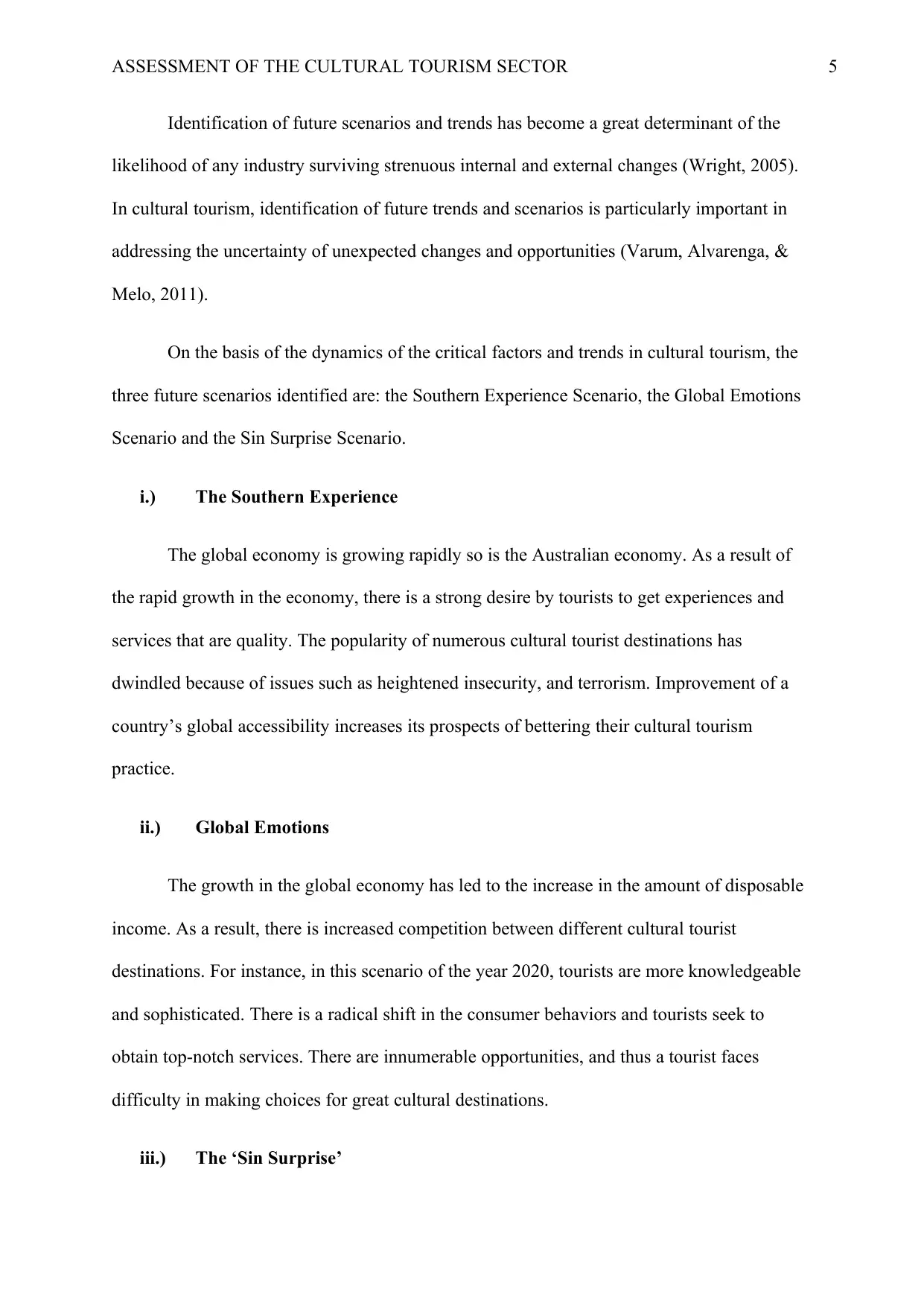
ASSESSMENT OF THE CULTURAL TOURISM SECTOR 5
Identification of future scenarios and trends has become a great determinant of the
likelihood of any industry surviving strenuous internal and external changes (Wright, 2005).
In cultural tourism, identification of future trends and scenarios is particularly important in
addressing the uncertainty of unexpected changes and opportunities (Varum, Alvarenga, &
Melo, 2011).
On the basis of the dynamics of the critical factors and trends in cultural tourism, the
three future scenarios identified are: the Southern Experience Scenario, the Global Emotions
Scenario and the Sin Surprise Scenario.
i.) The Southern Experience
The global economy is growing rapidly so is the Australian economy. As a result of
the rapid growth in the economy, there is a strong desire by tourists to get experiences and
services that are quality. The popularity of numerous cultural tourist destinations has
dwindled because of issues such as heightened insecurity, and terrorism. Improvement of a
country’s global accessibility increases its prospects of bettering their cultural tourism
practice.
ii.) Global Emotions
The growth in the global economy has led to the increase in the amount of disposable
income. As a result, there is increased competition between different cultural tourist
destinations. For instance, in this scenario of the year 2020, tourists are more knowledgeable
and sophisticated. There is a radical shift in the consumer behaviors and tourists seek to
obtain top-notch services. There are innumerable opportunities, and thus a tourist faces
difficulty in making choices for great cultural destinations.
iii.) The ‘Sin Surprise’
Identification of future scenarios and trends has become a great determinant of the
likelihood of any industry surviving strenuous internal and external changes (Wright, 2005).
In cultural tourism, identification of future trends and scenarios is particularly important in
addressing the uncertainty of unexpected changes and opportunities (Varum, Alvarenga, &
Melo, 2011).
On the basis of the dynamics of the critical factors and trends in cultural tourism, the
three future scenarios identified are: the Southern Experience Scenario, the Global Emotions
Scenario and the Sin Surprise Scenario.
i.) The Southern Experience
The global economy is growing rapidly so is the Australian economy. As a result of
the rapid growth in the economy, there is a strong desire by tourists to get experiences and
services that are quality. The popularity of numerous cultural tourist destinations has
dwindled because of issues such as heightened insecurity, and terrorism. Improvement of a
country’s global accessibility increases its prospects of bettering their cultural tourism
practice.
ii.) Global Emotions
The growth in the global economy has led to the increase in the amount of disposable
income. As a result, there is increased competition between different cultural tourist
destinations. For instance, in this scenario of the year 2020, tourists are more knowledgeable
and sophisticated. There is a radical shift in the consumer behaviors and tourists seek to
obtain top-notch services. There are innumerable opportunities, and thus a tourist faces
difficulty in making choices for great cultural destinations.
iii.) The ‘Sin Surprise’
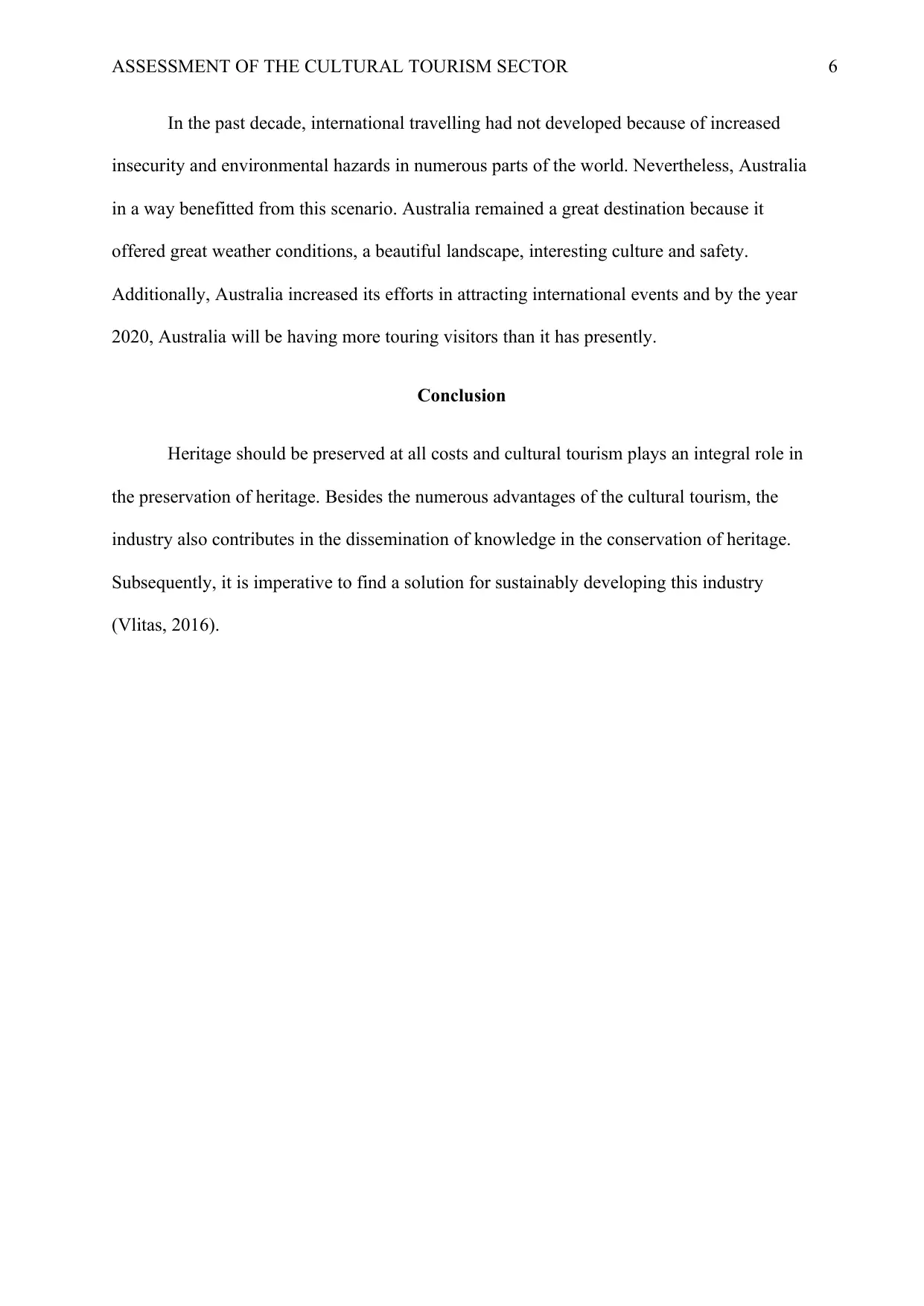
ASSESSMENT OF THE CULTURAL TOURISM SECTOR 6
In the past decade, international travelling had not developed because of increased
insecurity and environmental hazards in numerous parts of the world. Nevertheless, Australia
in a way benefitted from this scenario. Australia remained a great destination because it
offered great weather conditions, a beautiful landscape, interesting culture and safety.
Additionally, Australia increased its efforts in attracting international events and by the year
2020, Australia will be having more touring visitors than it has presently.
Conclusion
Heritage should be preserved at all costs and cultural tourism plays an integral role in
the preservation of heritage. Besides the numerous advantages of the cultural tourism, the
industry also contributes in the dissemination of knowledge in the conservation of heritage.
Subsequently, it is imperative to find a solution for sustainably developing this industry
(Vlitas, 2016).
In the past decade, international travelling had not developed because of increased
insecurity and environmental hazards in numerous parts of the world. Nevertheless, Australia
in a way benefitted from this scenario. Australia remained a great destination because it
offered great weather conditions, a beautiful landscape, interesting culture and safety.
Additionally, Australia increased its efforts in attracting international events and by the year
2020, Australia will be having more touring visitors than it has presently.
Conclusion
Heritage should be preserved at all costs and cultural tourism plays an integral role in
the preservation of heritage. Besides the numerous advantages of the cultural tourism, the
industry also contributes in the dissemination of knowledge in the conservation of heritage.
Subsequently, it is imperative to find a solution for sustainably developing this industry
(Vlitas, 2016).
⊘ This is a preview!⊘
Do you want full access?
Subscribe today to unlock all pages.

Trusted by 1+ million students worldwide
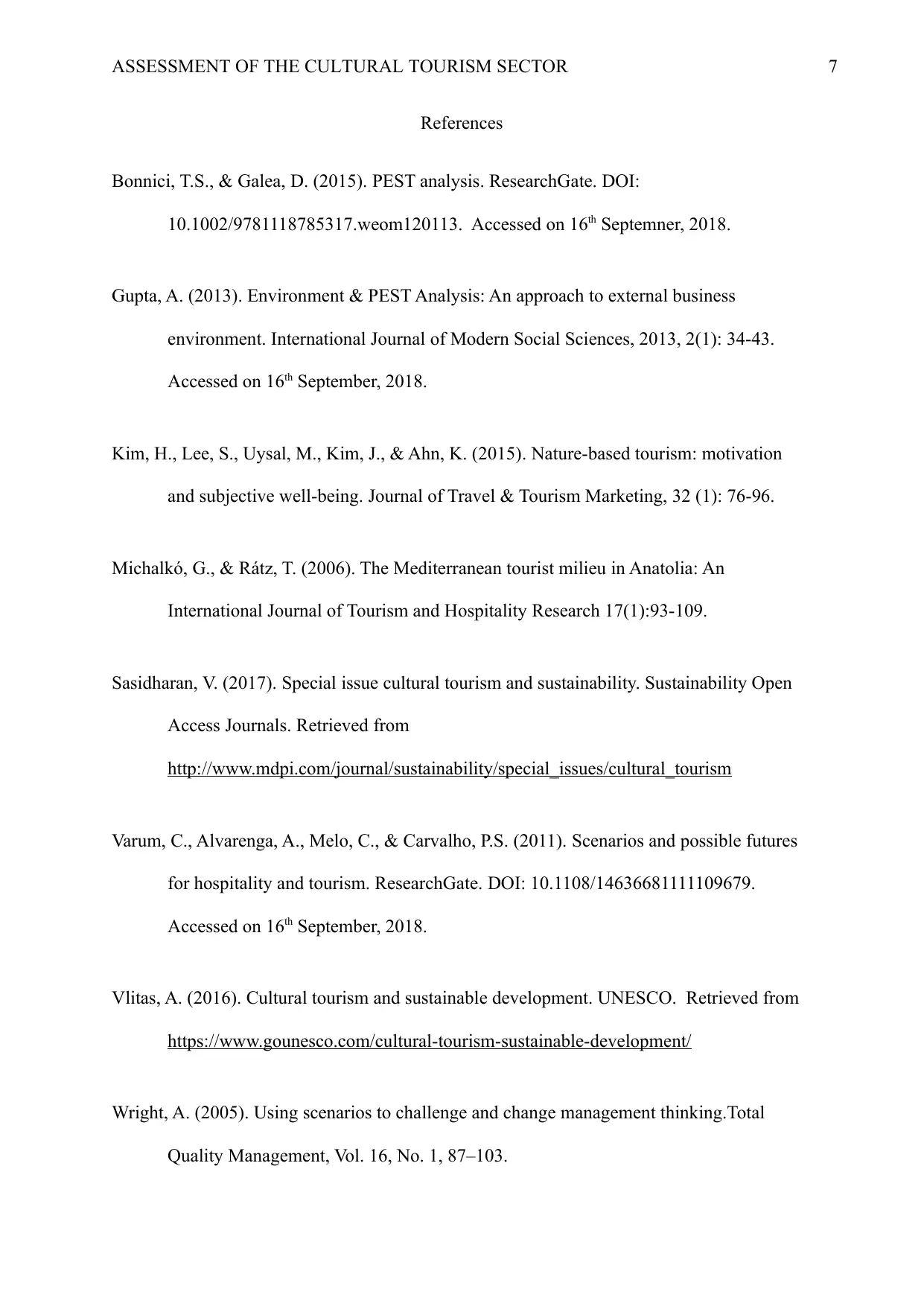
ASSESSMENT OF THE CULTURAL TOURISM SECTOR 7
References
Bonnici, T.S., & Galea, D. (2015). PEST analysis. ResearchGate. DOI:
10.1002/9781118785317.weom120113. Accessed on 16th Septemner, 2018.
Gupta, A. (2013). Environment & PEST Analysis: An approach to external business
environment. International Journal of Modern Social Sciences, 2013, 2(1): 34-43.
Accessed on 16th September, 2018.
Kim, H., Lee, S., Uysal, M., Kim, J., & Ahn, K. (2015). Nature-based tourism: motivation
and subjective well-being. Journal of Travel & Tourism Marketing, 32 (1): 76-96.
Michalkó, G., & Rátz, T. (2006). The Mediterranean tourist milieu in Anatolia: An
International Journal of Tourism and Hospitality Research 17(1):93-109.
Sasidharan, V. (2017). Special issue cultural tourism and sustainability. Sustainability Open
Access Journals. Retrieved from
http://www.mdpi.com/journal/sustainability/special_issues/cultural_tourism
Varum, C., Alvarenga, A., Melo, C., & Carvalho, P.S. (2011). Scenarios and possible futures
for hospitality and tourism. ResearchGate. DOI: 10.1108/14636681111109679.
Accessed on 16th September, 2018.
Vlitas, A. (2016). Cultural tourism and sustainable development. UNESCO. Retrieved from
https://www.gounesco.com/cultural-tourism-sustainable-development/
Wright, A. (2005). Using scenarios to challenge and change management thinking.Total
Quality Management, Vol. 16, No. 1, 87–103.
References
Bonnici, T.S., & Galea, D. (2015). PEST analysis. ResearchGate. DOI:
10.1002/9781118785317.weom120113. Accessed on 16th Septemner, 2018.
Gupta, A. (2013). Environment & PEST Analysis: An approach to external business
environment. International Journal of Modern Social Sciences, 2013, 2(1): 34-43.
Accessed on 16th September, 2018.
Kim, H., Lee, S., Uysal, M., Kim, J., & Ahn, K. (2015). Nature-based tourism: motivation
and subjective well-being. Journal of Travel & Tourism Marketing, 32 (1): 76-96.
Michalkó, G., & Rátz, T. (2006). The Mediterranean tourist milieu in Anatolia: An
International Journal of Tourism and Hospitality Research 17(1):93-109.
Sasidharan, V. (2017). Special issue cultural tourism and sustainability. Sustainability Open
Access Journals. Retrieved from
http://www.mdpi.com/journal/sustainability/special_issues/cultural_tourism
Varum, C., Alvarenga, A., Melo, C., & Carvalho, P.S. (2011). Scenarios and possible futures
for hospitality and tourism. ResearchGate. DOI: 10.1108/14636681111109679.
Accessed on 16th September, 2018.
Vlitas, A. (2016). Cultural tourism and sustainable development. UNESCO. Retrieved from
https://www.gounesco.com/cultural-tourism-sustainable-development/
Wright, A. (2005). Using scenarios to challenge and change management thinking.Total
Quality Management, Vol. 16, No. 1, 87–103.
1 out of 7
Related Documents
Your All-in-One AI-Powered Toolkit for Academic Success.
+13062052269
info@desklib.com
Available 24*7 on WhatsApp / Email
![[object Object]](/_next/static/media/star-bottom.7253800d.svg)
Unlock your academic potential
Copyright © 2020–2025 A2Z Services. All Rights Reserved. Developed and managed by ZUCOL.





